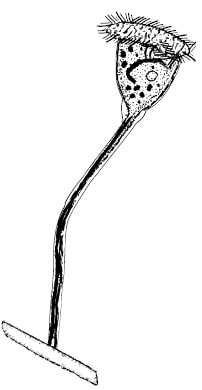 Stalk Ciliate - an ideal protozoa indicator
Stalk Ciliate - an ideal protozoa indicator First, the "bugs" we note using the microscope are mostly single celled protozoa and a few multicellular lifeforms. The bacteria - or the actual workers - can be seen as part of the floc or as very, very small particles in the water. Some bacteria can become filamentous in form or are large enough to be seen with microscope, but most even at 1000x appear as small rods or spheres.
We rely on the protozoa and higher life forms as indicator organisms for the underlying bacteria populations. For example, stalk ciliates are only present and active when there is sufficient dissolved oxygen and low levels of inhibitory or toxic compounds. This just happens to be where we are in decline phase growth or target F/M for most wastewater treatment plants. Multicellular forms such as rotifers, worms, or tardigrades appear even further along the F/M curve and can indicate old sludge or too low an F/M where you are carrying too much dead or inactive biomass.
I recommend looking under the microscope daily for the following:
- Floc size & density
- Filaments if present and estimate their relative abundance
- Protozoa present and in what abundance
- Multicellular life forms and abundance
While I use the microscopic exam daily, I also like to run newer molecular testing that looks directly into the floc's microbial community. With high throughput sequencing, we look at DNA in the system and find our which microbes are present and at what % of total biomass reads (identifying DNA segments). This is a total microbial census of the MLSS and is good to run when establishing a baseline population database, making operational changes or on a quarterly basis for tracking long term changes. Following Microbial Community Analysis (MCA), we identify key microbes that are most important for good treatment. We can then use qPCR technology to track these specific microbes. qPCR is faster, highly quantitative, and cheaper than the full microbial census (MCA).

 RSS Feed
RSS Feed